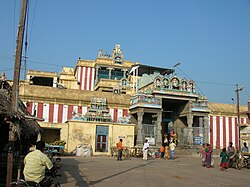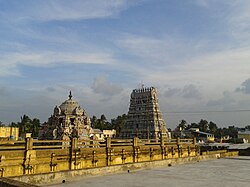Swaminatha Swamy Temple
| Swaminatha Swamy Temple | |
|---|---|
 View of the entrance | |
| Religion | |
| Affiliation | Hinduism |
| District | Thanjavur |
| Deity | Swaminatha(Kartikeya) |
| Location | |
| Location | Swamimalai |
| State | Tamil Nadu |
| Country | |
Parantaka Chola I | |
The Swaminatha Swamy Temple is a
As per Hindu legend, Murugan, the son of Shiva, extolled the meaning of the Pranava Mantra (
Nearby Eraharam Murugan temple
In the village of Eraharam there is a murugan temple known as Kandhanathaswamy thirukovil. This temple is considered to be the adhi temple of Swamimalai Swaminathaswamy temple. This Kandhanathaswamy temple can be reacher from kumbakonam and from thirupurambiyam.
Legend

According to regional Hindu legend,
Shiva came to Murugan and asked him to release Brahma from imprisonment. Murugan refused to release him stating Brahma was unaware of the meaning of the mantra Om. Shiva asked Murugan to explain the meaning and the latter did so. Shiva behaved like a student to a teacher, listening with rapt attention from his son, giving Murugan the name "Swaminatha Swami".[3] The meaning of this name is "The Teacher of Shiva".[4] Following the legend, the shrine of the son Murugan is atop the hillock, while the father Shiva's shrine is located at the basement.[5]
As per the
Architecture

The temple is located in
Religious importance
| Saptha Vigraha moorthis are the seven prime consorts in all Shiva temples located at seven cardinal points around the temple | ||
| Deity | Temple | Location |
| Shiva | Mahalingaswamy temple | Tiruvidaimarudur
|
Vinayaka |
Vellai Vinayagar Temple |
Thiruvalanchuzhi
|
Murugan |
Swamimalai Murugan temple |
Swamimalai |
| Nataraja | Natarajar temple |
Chidambaram |
| Durga | Thenupuriswarar Temple |
Patteswaram
|
| Dakshinamurti | Apatsahayesvarar Temple | Alangudi |
| Navagraha | Suryanar Kovil | Suryanar Kovil |
Swamimalai is one of the
According to Hindu legend,
Worship and religious practises

The temple priests perform the
Kumbakonam Sapta Sthaana Temple
This is one of the Saptha Sthaana Temples of Kumbakonam. During the Mahahaman of 2016 the palanquin festival was held on 7 February 2016.[26] Following the tirttavari held at Mahamaham tank on 21 April 2016, the palanquin festival of the Sapta Sthaana Temples were held on 23 April 2016.[27] The festival which started from Kumbesvara Temple at the 7.30 p.m. of 23 April 2016 completed on the morning of 25 April 2016 after going to the following temples.
- Adi Kumbeswarar Temple, Kumbakonam
- Amirthakadeswarar Temple, Sakkottai
- Avudainathar Temple, Darasuram
- Kabartheeswarar Temple
- Kottaiyur Kodeeswarar Temple
- Kailasanathar Temple, Melakaveri
- Swaminatha Swamy Temple
Notes
- ISBN 978-81-230-1661-0.
- ISBN 9788120907690.
- ^ a b Clothey 1978, pp. 127–128
- ^ Clothey 1978, p. 108
- ^ "Legend Connected with The Temple". Swaminathaswamy Temple administration. Archived from the original on 11 December 2013. Retrieved 30 November 2013.
- ISBN 9788179503973.
- ^ Bhoothalingam 2011, pp. 48–52
- ISBN 978-81-87952-12-1.
- ^ a b "Sri Swaminathaswami temple". Dinamalar. Retrieved 21 March 2013.
- ^ "What to see – Thanjavur district attractions". Thanjavur District Administration. Archived from the original on 18 May 2013. Retrieved 7 July 2013.
- ^ "About the Temple". Swaminathaswamy Temple administration. Archived from the original on 11 December 2013. Retrieved 30 November 2013.
- ^ Zvelebil 1991, p. 36
- ^ Meena, V. (1974). Temples in South India (1st ed.). Kanniyakumari: Harikumar Arts. p. 27.
- ^ "Thirukoil - Temple list of Tamil Nadu" (PDF). Hindu Religious & Charitable Endowments Department, Government of Tamil Nadu. p. 244. Archived from the original (PDF) on 9 October 2020. Retrieved 13 November 2021.
- ISBN 9780700712670.
- ^ Clothey 1978, p. 83
- ISBN 978-0-8239-3180-4.
- ISBN 978-81-7478-177-2.
- ^ a b Narayanaswami (April 1987). "Jyothirmaya Mahalingam". Om Sakthi (in Tamil). Coimbatore: Om Sakthi Publications: 34–5.
- ISBN 978-81-7017-471-4.
- ISBN 81-206-0151-3
- ISBN 90-04-04190-7
- ^ Zvelebil 1991, p. 53
- ^ a b "Festivals of the Temple". Swaminathaswamy Temple administration. Retrieved 30 November 2013.
- ^ "Kumbabishekam performed, The Hindu". 10 September 2015. Retrieved 3 December 2016.
- ^ கும்பகோணம் ஆதிகும்பேஸ்வரசுவாமி கோயிலில் சப்தஸ்தான பல்லக்கு வெள்ளோட்டம், தினமணி, 8 பிப்ரவரி 2016
- ^ ஆதி கும்பேஸ்வரர் கோயிலில் ஏழூர் பல்லக்கு பெருவிழா, மகாமகக்குளத்தில் தீர்த்தவாரி, தினமணி, 22 ஏப்ரல் 2016
References
- Clothey, Fred; Ramanujan, A.K. (1978). The many faces of Murukan: the history and meaning of a South Indian god. Mouton de Gruyter. ISBN 0-415-34438-7.
- Bhoothalingam, Mathuram (2011). S. Manjula (ed.). Temples of India – Myths and legends. Publications Division, Ministry of Information and Broadcasting, Government of India. ISBN 978-81-230-1661-0.
- Zvelebil, Kamil V. (1991). Tamil traditions on Subramanya – Murugan (1st ed.). Chennai, India: Institute of Asian Studies.




